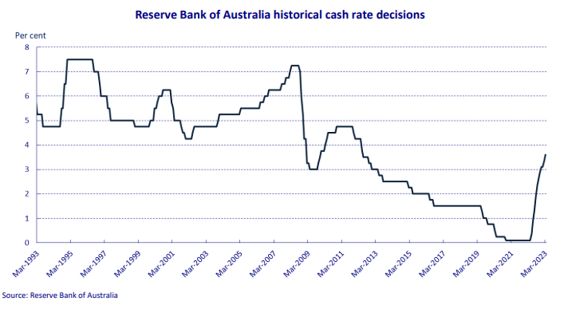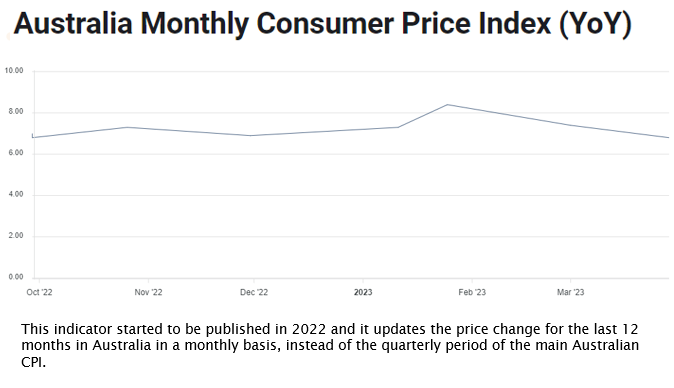- The Reserve Bank of Australia is expected to stay on hold, however, a 25 bps rate hike is possible.
- Inflation slowed down in February, still above target.
- AUD/USD stabilizing, offering mixed signs.
The Reserve Bank of Australia (RBA) will announce its monetary policy decision on April 4. The RBA has been raising the Cash Rate Target since March 2022 and, during the last five meetings, opted for 25 bps hikes. Back in February 2022, the rate was 0.1% and now stands at 3.6%.
On March 7, the RBA raised as expected and the Aussie dropped across the board. Governor Philip Lowe said, “the Board expects that further tightening of monetary policy will be needed to ensure that inflation returns to target and that this period of high inflation is only temporary,” and added that “in assessing when and how much further interest rates need to increase, the Board will be paying close attention to developments in the global economy, trends in household spending and the outlook for inflation and the labour market.”
According to the minutes of the meeting, Board members observed that inflation remained too high, the labor market was very tight and wage growth had picked up. Clearly, the RBA did not suggest the tightening cycle was over. As other central banks around the world, the RBA decisions are data-dependent. The day after the meeting Lowe said the central bank was closer to pausing rate hikes; also banking news started flooding headlines. The banking crisis appears to be contained for the moment, but added uncertainty to the global economic outlook.
The latest Australian economic numbers offered arguments for a hike and also for a pause. The economy added 64,600 payrolls in February and the Unemployment Rate dropped from 3.7% to 3.5%. Retail Sales rose by 0.2% in February, in line with expectations. Sales have been around the same levels since November 22, a warning sign about consumer spending and an argument for a pause for the RBA. The Monthly Consumer Price Index (CPI) came in below expectations. The annual rate dropped to 6.8% in February from 7.4% in January. This marked the second decline in a row, but still above the 2-3% target range.
Many banks and analysts adjusted their forecasts for the RBA after the CPI data, from a 25 bps rate hike to no change, not only because of the lower inflation but also considering the impact of the banking turmoil.
A pause is coming at the RBA; however, April could not be the time. The European Central Bank and the Federal Reserve pushed with hikes despite recent developments. Inflation remains elevated and the labor market is tight. Nevertheless, it is worth adding that the economic outlook has worsened. All in all, there is still room for more rate hikes, while at the same time, a pause also seems prudent considering the inflation trend and the uncertainty.
AUD/USD sideways, undecided like market forecasters
Considering the current environment, with doubts about the future of the economy, the impact of the RBA could be short-lived, particularly if it proceeds without major surprises. What could impact the most is how officials see the economy and their outlook. The AUD/USD should benefit from an upbeat perspective. On the contrary, a cautious central bank opting to stay on hold and pointing out that it could stay that way for a while should be (very) negative for the Aussie.
The AUD/USD is moving sideways near 0.6700. The daily chart shows the 200-period Simple Moving Average waiting at 0.6770. A break higher should point to further gains over the medium term while, on the contrary, below 0.6630, to more losses to test March lows at 0.6560.
AUD/USD daily chart
Information on these pages contains forward-looking statements that involve risks and uncertainties. Markets and instruments profiled on this page are for informational purposes only and should not in any way come across as a recommendation to buy or sell in these assets. You should do your own thorough research before making any investment decisions. FXStreet does not in any way guarantee that this information is free from mistakes, errors, or material misstatements. It also does not guarantee that this information is of a timely nature. Investing in Open Markets involves a great deal of risk, including the loss of all or a portion of your investment, as well as emotional distress. All risks, losses and costs associated with investing, including total loss of principal, are your responsibility. The views and opinions expressed in this article are those of the authors and do not necessarily reflect the official policy or position of FXStreet nor its advertisers. The author will not be held responsible for information that is found at the end of links posted on this page.
If not otherwise explicitly mentioned in the body of the article, at the time of writing, the author has no position in any stock mentioned in this article and no business relationship with any company mentioned. The author has not received compensation for writing this article, other than from FXStreet.
FXStreet and the author do not provide personalized recommendations. The author makes no representations as to the accuracy, completeness, or suitability of this information. FXStreet and the author will not be liable for any errors, omissions or any losses, injuries or damages arising from this information and its display or use. Errors and omissions excepted.
The author and FXStreet are not registered investment advisors and nothing in this article is intended to be investment advice.
Recommended Content
Editors’ Picks

EUR/USD struggles to hold above 1.0400 as mood sours
EUR/USD stays on the back foot and trades near 1.0400 following the earlier recovery attempt. The holiday mood kicked in, keeping action limited across the FX board, while a cautious risk mood helped the US Dollar hold its ground and forced the pair to stretch lower.

GBP/USD approaches 1.2500 on renewed USD strength
GBP/USD loses its traction and trades near 1.2500 in the second half of the day on Monday. The US Dollar (USD) benefits from safe-haven flows and weighs on the pair as trading conditions remain thin heading into the Christmas holiday.

Gold hovers around $2,610 in quiet pre-holiday trading
Gold struggles to build on Friday's gains and trades modestly lower on the day near $2,620. The benchmark 10-year US Treasury bond yield edges slightly higher above 4.5%, making it difficult for XAU/USD to gather bullish momentum.

Bitcoin fails to recover as Metaplanet buys the dip
Bitcoin hovers around $95,000 on Monday after losing the progress made during Friday’s relief rally. The largest cryptocurrency hit a new all-time high at $108,353 on Tuesday but this was followed by a steep correction after the US Fed signaled fewer interest-rate cuts than previously anticipated for 2025.

Bank of England stays on hold, but a dovish front is building
Bank of England rates were maintained at 4.75% today, in line with expectations. However, the 6-3 vote split sent a moderately dovish signal to markets, prompting some dovish repricing and a weaker pound. We remain more dovish than market pricing for 2025.

Best Forex Brokers with Low Spreads
VERIFIED Low spreads are crucial for reducing trading costs. Explore top Forex brokers offering competitive spreads and high leverage. Compare options for EUR/USD, GBP/USD, USD/JPY, and Gold.



-638158836567386201.png)